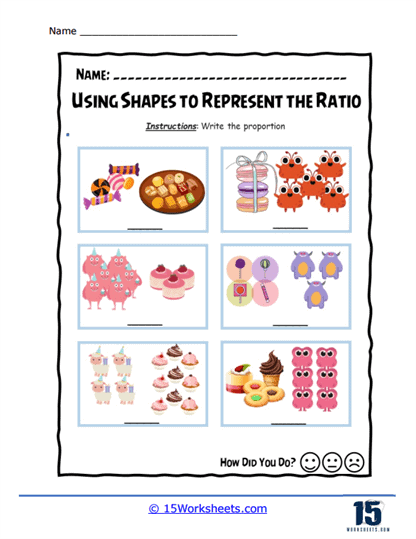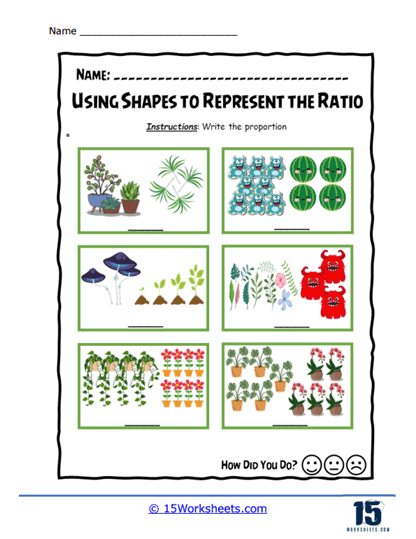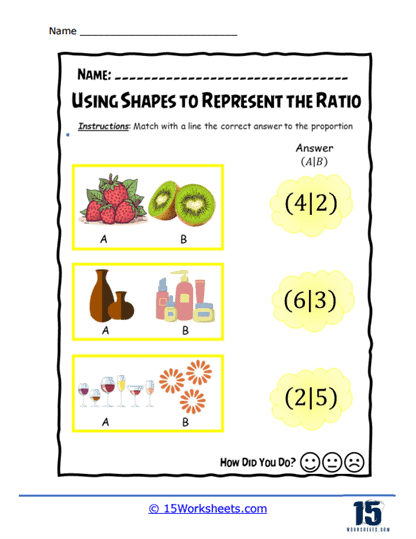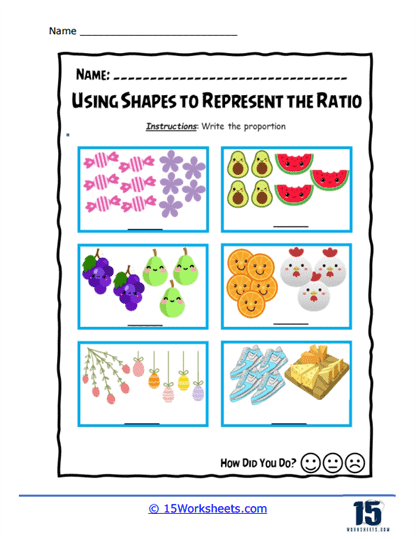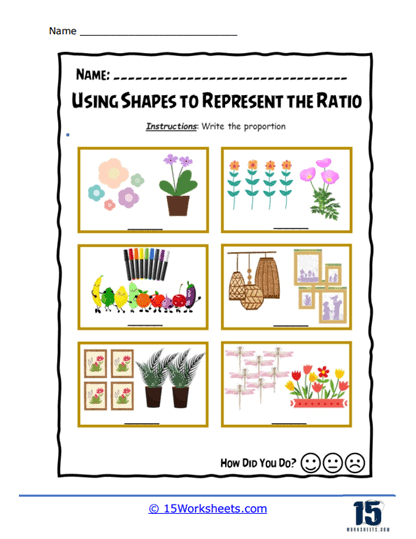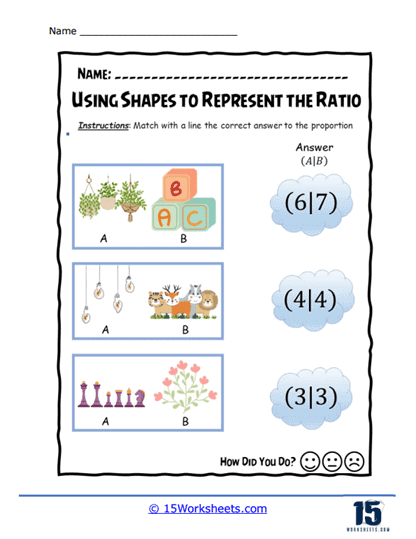Representing Ratios Worksheets
All About These 15 Worksheets
This worksheet collection is designed to provide an engaging and comprehensive set of exercises for students to master the concept of ratios through visual representation. This collection of worksheets is ideal for classroom instruction, homeschooling environments, or independent practice, offering students a visual and interactive way to explore ratios. The worksheets are available in a convenient PDF format, making them easy to download, view, and print for seamless integration into any lesson plan or study routine.
Types of Exercises
The primary focus of reducing ratios worksheets is to present students with a variety of ratio problems and guide them in simplifying these ratios. On these worksheets, you will often find problems that involve reducing ratios expressed in different forms, including:
Whole Number Ratios
These are the most common types of problems where students are asked to simplify ratios of whole numbers. For instance, a worksheet might ask students to reduce the ratio 24:36. To do this, students must find the greatest common divisor (GCD) of both numbers and divide each number by that GCD. In this case, the GCD of 24 and 36 is 12, so the ratio reduces to 2:3. Worksheets with these types of problems help students practice their skills in finding factors and simplifying.
Fractional Ratios
In some worksheets, ratios are presented as fractions, and students must reduce the ratios by simplifying the fractions involved. For example, the ratio might be given as 3/4 : 6/8. Students would be required to simplify each fraction first, recognizing that 6/8 simplifies to 3/4, leading to the reduced ratio of 3/4 : 3/4 or 1:1. These types of problems encourage students to work with fractions, a critical skill in both academic and real-world contexts.
Decimal Ratios
Occasionally, reducing ratios worksheets will present problems where the ratios are in decimal form, such as 2.5:5. Students must first convert these decimals to whole numbers by multiplying both terms by the same factor (in this case, 10), turning the ratio into 25:50, which can then be reduced to 1:2. Decimal ratios force students to think about scaling and proportionality in a slightly different way, helping them understand that ratios can appear in various forms and still be simplified.
Comparing Ratios
Some worksheets include problems where students are asked to compare two or more ratios to determine if they are equivalent. For example, a worksheet might present the ratios 4:6 and 6:9 and ask whether these two ratios are the same. Students must reduce both ratios to 2:3 and see that they are indeed equivalent. These exercises reinforce the concept of proportional relationships and allow students to practice critical thinking by analyzing how different ratios relate to each other.
Proportions and Cross Multiplication
Worksheets often introduce proportions as an extension of reducing ratios. A proportion is an equation that states that two ratios are equal. For example, a problem might ask if the ratios 2:3 and 4:6 are proportional. To solve this, students could reduce both ratios or use cross multiplication to confirm that the products of the terms (2×6 and 3×4) are equal, confirming that the ratios form a proportion. This type of practice helps students develop the skills necessary to solve more advanced algebraic problems.
Ratios with Different Units
Another variation of ratio problems found on these worksheets involves working with ratios that include different units, such as converting feet to inches or miles to kilometers. For example, a worksheet might present a problem where students must simplify the ratio of 3 feet to 36 inches. To reduce this ratio, students must first convert the units so that both are the same, in this case, converting feet to inches (3 feet = 36 inches), leading to the simplified ratio of 36:36, or 1:1. Working with different units not only helps students understand ratios but also teaches them unit conversion, a valuable skill in science, engineering, and daily life.
Engaging Visual Representation of Ratios
At the core of this collection are vibrant, image-based problems that challenge students to understand and apply the concept of ratios by counting and comparing objects in various shapes, colors, and arrangements. For example, students are asked to determine the ratio of squares to flowers, or glasses to cats, by carefully counting and identifying the elements in each group. These types of problems encourage the development of critical thinking and problem-solving skills, allowing students to visually break down ratios into their component parts.
The bright colors and creative imagery used in these worksheets make learning ratios more accessible and enjoyable. By visually associating numbers with real-world objects and patterns, these activities help students grasp ratios in a tangible way. This makes the collection especially useful for younger students who are still developing their mathematical reasoning.
Diverse Set of Activities
This collection covers a variety of activities focused on helping students build and refine their understanding of ratios. In addition to finding ratios based on visual representations of objects, some worksheets in the collection encourage students to match shapes to corresponding ratios, fostering recognition skills and mental agility. For instance, students might match pictures of animals, flowers, or other objects to the correct ratio, enhancing their ability to connect abstract concepts with concrete examples.
Other worksheets in the collection challenge students to write the ratios themselves, given sets of objects in different proportions. This transition from identifying ratios to writing them encourages independence and confidence in applying the mathematical concept. The inclusion of both multiple-choice and open-ended problems provides variety in the learning process, making the worksheets suitable for different learning styles and grade levels.
Teachers can easily integrate these worksheets into their lesson plans, either as part of classroom instruction, homework assignments, or supplementary activities for students who need extra practice. The worksheets are equally beneficial for homeschoolers, providing structured exercises that help reinforce lessons on ratios in a visual and interactive way.
Each worksheet comes in a printable PDF format, ensuring ease of use. Teachers and parents can download and print the materials quickly, without the need for additional preparation. The collection’s diverse approach ensures that students receive a well-rounded understanding of ratios, from basic identification to more complex applications.
Whether you’re a teacher looking to enhance your lesson plans, a parent supporting your child’s learning at home, or a homeschooler seeking a solid resource to teach ratios, this worksheet collection offers the tools you need. The PDF format ensures that the materials are accessible and ready for immediate use, providing a smooth learning experience for everyone involved.

